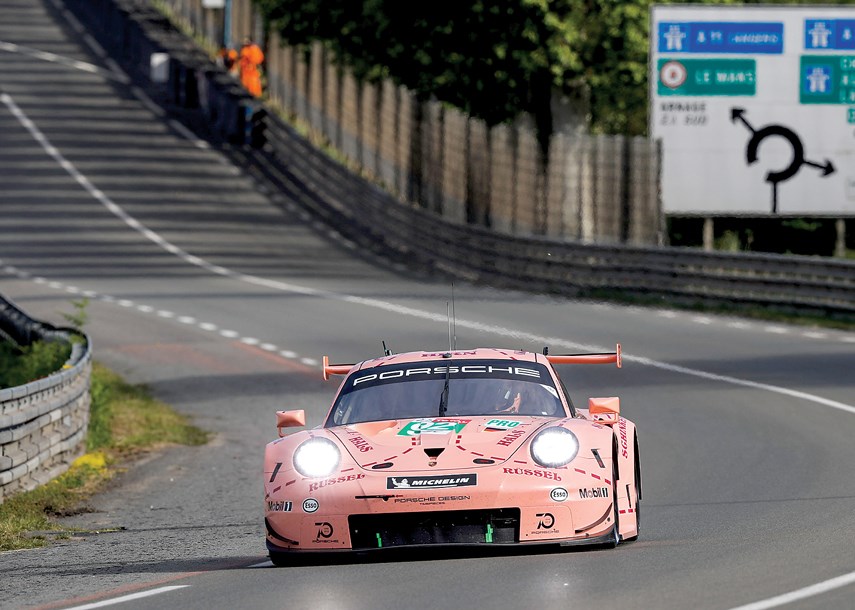A biweekly roundup of automotive news, good, bad and just plain weird:
Porsche rolls out two historic liveries
Porsche does historic racing liveries the way Las Vegas acts do costume changes. The manufacturer has a deep closet filled with iconic war paint, and it trots them out from time to time, just to make sure everyone remembers the golden days of speed.
For the 24 Hours of Le Mans this year, Porsche is staying out of the prototype class, and instead competing with the 911 RSR, a mid-engined variant of the 911. To make sure that the move doesn’t look like backing down, they’ve chosen to dress up two of the factory entries like some of their greatest hits.
One car will wear the red, white, blue, and gold of the old Rothman’s livery, while the other is even more interesting. It’s kitted out like the infamous Pink Pig, the bulbous-looking 917/20 “Truffle Hunter” that showed that Germans might actually have a sense of humour. When the original’s dimensions were made fun of by the press, the team painted the car like a butcher’s diagram of cuts of meat.
The Rothman’s car looks pretty decent. As for the Pink Pig redux, it’s not exactly a slimming colour on a car that’s sometimes accused of being a bit porcine. Maybe there’s a vegetarian option?
Challenger and Charger to live on
Having spent 3,000 kilometres in a Challenger over two and a half days a couple of weeks ago, I can tell you that big and dumb is sometimes what absolutely works. The LX platform on which the Brampton, Ont., built Dodge Challenger and Charger ride is old and unsophisticated, but it’s still a great drive. Especially if you’ve got to put miles under your wheels.
Fiat-Chrysler’s plans for the future were once to expunge the bulk of the Charger/Challenger, and replace them with cars underpinned by a new, European-style global chassis, the Alfa-Romeo Giorgio platform. Dodge, however, doesn’t really do Giorgio. It’ll stretch to building a George, but that’s about it.
In presentations this week, FCA CEO Sergio Marchionne confirmed that the Challenger and Charger would live on with their dinosaur-old LX bones, albeit with major updates. This is great news if you happen to be a proponent of Canadian manufacturing, as it seems likely that the Brampton Assembly plant will stay in business.
Corvette pace car crash holds up race
There’s getting egg on your face and then there’s getting wall on your car. For General Motors executive VP Mark Reuss, Detroit’s annual IndyCar road course featured the latter.
Piloting a new 750 horsepower ZR1 Corvette as pace car, Reuss came up over a brief crest, appeared to hit a small bump in the track, and then speared into the wall. Happily, no one was hurt, but the race was held up by about half an hour.
Highly embarrassing stuff, especially in front of the assembled cameras of the world. The crash, however, will arguably end up being good for the brand. Corvettes aren’t expected to be easy to drive, and the ZR1 variant is intended to be a complete monster, capable of taking on the world’s best. Reuss’s misstep in apparently turning off the traction control completely on a notoriously bumpy course isn’t likely to scare away would-be buyers. Rather the opposite, once machismo gets involved.
As usual, there’s a lesson for everyone here. Even if your car doesn’t have the power of the ultimate expression of Corvette-dom, think hard before you switch off traction control completely, even on the track. The world might not be watching, but the walls will be only too happy to say hello.
‘Super Cruise’ coming to Cadillac lineup
Tesla calls their semi-automated driving assistance package Autopilot, and it’s been in the news for reasons the company would rather avoid. Misuse of the system or design flaws have resulted in a couple of high profile crashes, most notably into a parked fire engine. Which, you know, most human drivers might be able to avoid.
Cadillac’s system is called Super Cruise, which is a bit more accurate description of what it does. Instead of being touted as an autonomously driven car, it’s a more advanced cruise control system, one intended to take the drudgery out of highway traffic.
Further, and this is the important bit, Super Cruise has a number of backup systems that are intended to make sure the driver is actually paying attention, and is ready to take over in the event that the system stops reading the road. It’s not perfect yet, but it is safer.
With their system receiving critical acclaim, GM is now rolling out Super Cruise throughout their Cadillac range, with the option to become available on every new Cadillac sold. Think of it not as having a personal chauffeur installed – at least, not yet – but as a step towards making driving a Cadillac more effortless.
Further, we’ll likely see the technology showing up in other GM products, especially higher-end models. Could Super Cruise change the dynamics of your next great road trip? It’d certainly help out for crossing the Prairies. And maybe a pace car lap or two.
Watch this space for all the best and worst of automotive news, or submit your own auto oddities to [email protected].



